
 Interview
with the Artist:
Interview
with the Artist:Tea Time with Joan Vilms
by Meredith Fahn
Joan Vilms lives on a quiet residential street near downtown Santa Rosa, not far from the YMCA. She greets me outside with her little black dog Osito, aka Osie. Osie, a 16-pound Schipperke, has assumed his snarling guard dog role, but Joan calls him aside. Before entering the house, Joan has me duck my nose into a giant yellow ginger blossom. High on Hawaiian honeysuckle, I ascend the brick stoop, on which free-form stacks of raw stones are balanced perfectly atop one another, in some cases smaller rocks nestled in the hollows of ones larger.
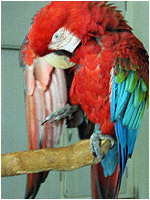 Inside,
feathers abound, and for good reason—Chaka the greenwing macaw
flies by, her three-foot wingspan trailing heavy turbulence. Carved stone
figures are perched on many surfaces all around the high-ceilinged room—animal
friends and abstract shapes, an apricot seal named Little Tubby, a green
grizzly with an immense butt, a cat sleeping on a fur blanket, a critter— possibly
a baboon—in contemplation atop a pyramidal paper sculpture that
was once a phone book.
Inside,
feathers abound, and for good reason—Chaka the greenwing macaw
flies by, her three-foot wingspan trailing heavy turbulence. Carved stone
figures are perched on many surfaces all around the high-ceilinged room—animal
friends and abstract shapes, an apricot seal named Little Tubby, a green
grizzly with an immense butt, a cat sleeping on a fur blanket, a critter— possibly
a baboon—in contemplation atop a pyramidal paper sculpture that
was once a phone book.
Sounds of several species mingle as Chaka, now on the floor, spars with
Osie next to a hula hoop—the only object that stops the advance
of the bird, who would otherwise dominate totally. 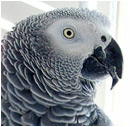 And
then...what is that?! Whistling from a back room: a smaller bird—an
androgynous African grey named Angie—repeats the last few bars
of "Things ain't what they used to be." Everybody's present,
except for Peeter Vilms, Joan's husband and best friend, an artist in
his own right, and her partner for well over 30 years. Peeter is downtown
lending a hand at the Environmental Center, which has today become the
Event Center for First Flush in the Russian River basin. After all, it
is fall, we just had our first rains and intrepid volunteers associated
with Russian
Riverkeeper and friends are delivering water samples from all over
the watershed.
And
then...what is that?! Whistling from a back room: a smaller bird—an
androgynous African grey named Angie—repeats the last few bars
of "Things ain't what they used to be." Everybody's present,
except for Peeter Vilms, Joan's husband and best friend, an artist in
his own right, and her partner for well over 30 years. Peeter is downtown
lending a hand at the Environmental Center, which has today become the
Event Center for First Flush in the Russian River basin. After all, it
is fall, we just had our first rains and intrepid volunteers associated
with Russian
Riverkeeper and friends are delivering water samples from all over
the watershed.
Empty walnut shells crunch underfoot as we make our way to the kitchen table for our extra-large cups of chai, with real heavy cream. Joan has her tea with peanut butter and celery; for me, it is peanut butter and a Fuji apple. Once Osie gets his dinner of home-cooked vegetables and raw meat, the interview begins.
MEREDITH FAHN: You work in three separate media: beads, carvings and paintings. Which is your favorite?
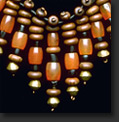 JOAN
VILMS: It's a function of cycles, depending
on what I'm doing at the time. For a long time, necklace weaving was
my favorite…and I consider it to be my best stuff. But what a question!
It's like asking which child you love more!
JOAN
VILMS: It's a function of cycles, depending
on what I'm doing at the time. For a long time, necklace weaving was
my favorite…and I consider it to be my best stuff. But what a question!
It's like asking which child you love more!
What I love is the process of discovery and rediscovery, so after a period of time, you look back with fresh eyes and discover it all new, like somebody else did it. That's fun too.
MF: What is it that you discover when you do your artwork?
JV: What the thing wants to be. What the stone wants to become, what's going to happen with the paint that day. The one with the most intention is the necklaces. I often have a firm idea of where I'm going, but I'm open to it if the beads rearrange themselves. It's a relationship with the materials and the tools. It's always different, always “the first time.”
MF: What kinds of tools do you use in your stone work?
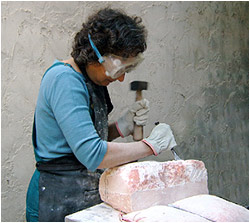 JV: Mallet,
chisels, rasps, sandpaper. The only electric tool is a buffer at the
end.
JV: Mallet,
chisels, rasps, sandpaper. The only electric tool is a buffer at the
end.
MF: You sculpt from large rocks. It seems pretty industrial. Why don't you use any power tools except the buffer?
JV: I like the immediacy of the relationship with the rock. The slow process allows the thing to reveal itself.
MF: Why do you work in acrylics for your paintings?
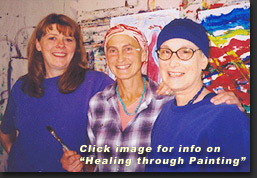 JV: Because
that is what is provided!
JV: Because
that is what is provided!
The painting is a different process. It's something I got involved with while dealing with breast cancer. "Healing Through Painting" is a group for cancer survivors. I am so grateful for that program, and I especially hope to sell paintings to help support it—because a substantial portion of all of my paintings sales will be donated to that program.
MF: What other media have you explored?
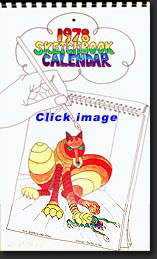 JV: I
have a whole cabinet full of sketchbooks I've been filling my whole
life, it seems. In 1978 we did a limited-edition "Sketchbook Calendar" using
color Xerox. So I've been drawing and sort of coloring for many years—but
never painting, until I got breast cancer and started chemotherapy.
JV: I
have a whole cabinet full of sketchbooks I've been filling my whole
life, it seems. In 1978 we did a limited-edition "Sketchbook Calendar" using
color Xerox. So I've been drawing and sort of coloring for many years—but
never painting, until I got breast cancer and started chemotherapy.
In college, I experimented with plaster and worked with wood a bit; I worked a very little bit with clay. I have been collecting wood and might work with it again sometime—anything is possible. And while I really like alabaster, in the end it's whatever moves me. You can't help yourself—it's an itch and you have to scratch it.
MF: When did you get started with necklaces?
JV: I've been taking things apart and putting them back together for as long as I can remember. I always made bracelets and necklaces and stuff as a kid. In fact, Mom kept a box of old jewelry and odds and ends I could mess with, to divert me from getting into the things she didn't want me to mess with.
MF: When you work, do you like silence or music? Company or solitude? How do you like your environment to be?
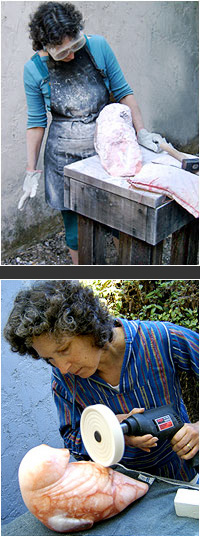 JV: Well,
necklaces are an indoor activity, so it doesn't really matter. I'm
happy for company...or not. [Smirk]
JV: Well,
necklaces are an indoor activity, so it doesn't really matter. I'm
happy for company...or not. [Smirk]
With painting, it's with the group, always. I've never painted at home. Sometimes they play music but I'm good at tuning it out. I may not be very good company when I'm doing it. I'd love for someone to keep me company...but who would want to?
And with the stone...it's messy, so I'm outside, and I have to wear goggles and a mask. Osie comes out with me but even then he stays around the corner. I like the sound of birdsong, the trees and the wind. And of course the whack whack and scrape scrape.
MF: Does the energy of the painting group affect or influence your discovery of the paint?
JV: I'm sure it does—everything affects everything—but for me, not on a conscious level. A lot of the other women paint more consciously, and their paintings tell stories. I try to quiet my mind and follow the paint. And the same thing with the rock. The mind gets in the way, and hits you with “shoulds” and judgment.
MF: Tell me if you agree or disagree with this statement: “In art, there are no mistakes.”
JV: [Heh heh heh.] I'd like to agree, and it's true a lot. But it's not 100% true.
I will go with the “mistakes.” You whack off a chunk of rock, and think “Whoops!” But then you work with the rock in that form. That's where you challenge yourself, that's where the discovery is. Like a puzzle. I've always loved puzzles: jig saws, cryptograms, mechanical puzzles…
MF: For you then, is art a convergence of puzzles and aesthetics?
JV: No, puzzles and SURPRISES! “Aesthetics” sounds too high-falutin'.
MF: What else drives you to make art?
JV: If you make music, you make it and it's gone, and a lot of people appreciate that. I like to make something and be able to look at it. I love going back and forth in relationship with an object and coming out some place I never dreamed I would be.
One of the really hard things is “trusting
the process.” The hardest is with the things you like because you
bring all this baggage with it. You want it to be good, you want it to
be better than the one before. But you have to turn all that off and
just let it happen. It gets harder and harder over time. You would think
it gets easier, but it does not. It gets harder. Starting is hard. This
100 pound stone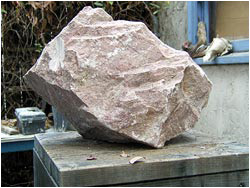 —I've
had it ready to go for weeks—and I am procrastinating with every
reason not to start it.
—I've
had it ready to go for weeks—and I am procrastinating with every
reason not to start it.
click picture for update >>>
Trust is crucial. It's a microcosm for life. If I could transform what I do with the rock into the rest of my life, I probably would not have this compulsion to make and do other things. Even though it scares me, I get great satisfaction from it—more so than with social interaction, which I consider myself to be really bad at.
 |
Click
for full image |
MF: With painting, does the group energy and setting help you get started?
JV: Probably. But again it's a process, step by step by step, and it draws you in. You put the paints on the palette, you mix them, you put them on the paper. Same with the carving—you sharpen your tools, you circle the rock.
Martia Nelson, the Healing Through Painting group leader, refers to our paintings as “love letters from our soul”—even, maybe especially, the ones we don't like.
MF: Is art unique to our species?
JV: [Raised eyebrows.] The word certainly is. In my case, it's a kind of play, and there's plenty of evidence of playfulness in other species.
MF: Bob Dylan sang, “She's an artist, she don't look back.” What does that mean?
JV: I think it's about being present, and
being absorbed with what you are doing next. Not next week or next
year, but the next second. When you are totally absorbed there's no
time to look back. Plus, it's turning off the part of your brain that
would be analytical about looking back, because you bring everything
from your past with you, and you have to trust that.  I
don't really know what Bob Dylan meant, but that's what it means to
me.
I
don't really know what Bob Dylan meant, but that's what it means to
me.
MF: There is an art even to the placement of your objects, the way you have dark stones set into the Embrace sculpture, the Cat Sleeping on the fur, the feather art and willow branches all around your house, the carefully shredded paper platform that the Baboon in Contemplation sits on...
JV: [Hysterical laughter] That's Angie's work! She chewed on that phone book for weeks!
-- Interview took place on October 17, 2004